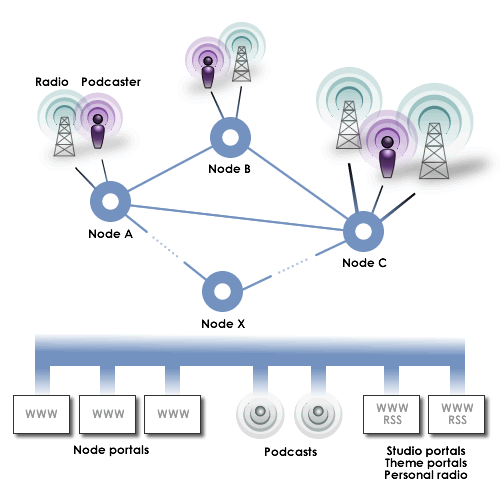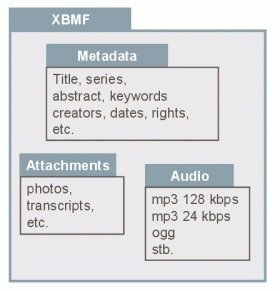
URL of the service: http://radio.sztaki.hu
The service radio.sztaki.hu is a member of the StreamOnTheFly networked archiving and exchange system. It can be used for digital audio data, such as radio programmes and podcasts, but also for audio arts and any other meaningful data you can imagine. StreamOnTheFly can be used either as a platform to publish content or as a source for thousands of hours of radio and podcasting programmes.
Community broadcasters are non-profit, are open to the general public and have a local or regional scope. They provide access to radio and TV production facilities for organizations, groups and individuals aiming to make their own programs or shows. Community radio stations and TV channels would like to be able to archive, exchange and stream content over the Internet, but appropriate tools are not yet available at an affordable price. They have therefore expressed a desire to set up a robust distributed infrastructure with a technological solution that is flexible, effective and low-cost.
In 2002, the StreamOnTheFly project with the participation of Public Voice Lab (Austria), SZTAKI and Team Teichenberg (Austria) obtained grants from the European Commission's IST Programme to build a middleware application for radio with various front ends. StreamOnTheFly was focused on next-generation audio content management and broadcasting offering a customizable community radio program. It is now able to demonstrate new methods of management and personalization technologies for both audio and video. It also provides a collaboration platform that suits the flexible activity patterns of local broadcaster communities.

The StreamOnTheFly network
The original StreamOnTheFly architecture consisted of three main components:
- station control: a Web application to manage radio broadcasting, programme scheduling, and the archiving and publishing of selected programmes to node servers
- node server: a distributed network of servers containing the archived programmes with their metadata, access statistics and usage history; users may browse for interesting materials, and compile personalized radio streams for listening
- portal server: personal or community selections of content can be presented in a customized format; the archived content is revitalized through various subjective filters.
The core of the StreamOnTheFly network combines peer-to-peer networking and open-archive principles, while other services are realized as separate network components communicating through open interfaces (APIs). There is no central server in the network, and metadata is exchanged in a peer-to-peer manner. The content is stored on the node of the publisher while all content metadata is available on all node servers. This enables fast searching and browsing with reasonable storage requirements.

The XBMF format for archival and exchange of broadcast audio
A simple exchange format called XBMF (Exchange Broadcast Binary and Metadata Format) is a core element of the network. XBMF enforces the coupling of metadata with content, and also creates the possibility of providing content in different audio formats, or attaching different media (eg images, text) to the audio content.
During the evolution of the StreamOnTheFly network the node server component (archive) remained in focus, while the other two components (station control, portal) were made replaceable using standard communications. A plug-in for free, professional, radio station management software is under development: this will support the archiving of programmes on node servers. RSS 2.0 or OAI-PMH (Open Archives Initiative - Protocol for Metadata Harvesting) are used to promote archived content to portal engines (eg Typo3, Manila, Plone) and search engines. Via podcasting, selected content can be easily transferred to PDAs, iPods and other handheld devices.
The StreamOnTheFly network is operational since October 2003. In late 2006 the core of the network (five network nodes) is accessible in four languages (English, German, French and Hungarian), and contains more than 2500 hours of audio content. Other applications of the software include an exhibition, school and fair radios, e-learning and linguistic projects. The StreamOnTheFly software suite is open-source and licensed under the GNU General Public License.
Although the StreamOnTheFly project officially finished in June 2004, voluntary work is continuing to implement various extensions and use cases. Since that time StreamOnTheFly has proved its flexibility and extensibility in several cases. The architectural decisions made in StreamOnTheFly justified themselves as an open and scaleable base for further developments.
